Investigation of the Testing Method of Softening–Melting Properties of Iron-Bearing Materials
Abstract
1. Introduction
2. Experiments
2.1. Materials
2.2. Softening–Melting (S&M) Under Load Method
2.3. Quenching Experiment
3. Results
3.1. Reduction Index in Gas–Solid Reduction
3.2. Comparison Between the Tested Data and Actual BF
4. Discussions
4.1. S&M Characteristics
4.2. Permeability
4.3. Dripping Behavior
5. Conclusions
- Under the novel softening–melting testing method, the values of RIC1000 and RIN1000 of the sinter reached 25.41% and 59.58%, respectively. For the pellet, these values were 14.95% and 40.34%, respectively. Consequently, the reduction indices obtained in the novel method are consistent with the actual blast furnace.
- Under the conventional softening–melting testing method, the reduction indices (RI) of the sinter at 700 °C, 800 °C, 900 °C, 1122 °C (T10), 1200 °C, 1218 °C (T40), and 1274 °C (TS) are 4.95%, 13.52%, 11.29%, 25.41%, 32.38%, 42.12%, 64.19%, and 69.55%, respectively. In contrast, under the novel softening–melting testing method, the reduction indices of the sinter at 700 °C, 800 °C, 900 °C, 1125 °C (T10), 1200 °C, 1292 °C (T40), and 1315 °C (TS) are 8.61%, 17.13%, 40.26%, 59.58%, 78.29%, 82.90%, 90.54%, and 96.81%, respectively. Furthermore, the reduction indices observed under actual blast furnace conditions at 1000 °C, 1100 °C, and 1300 °C are 49.1%, 99.3%, and 99.4%, respectively. One can conclude that the novel softening–melting method is consistent with the reduction conditions observed in an actual blast furnace. Consequently, reduction indices and the metallization degree of iron-bearing materials are consistent with those observed in an actual blast furnace.
Author Contributions
Funding
Data Availability Statement
Acknowledgments
Conflicts of Interest
References
- Elices, M.; Guinea, G.V.; Gómez, J.; Planas, J. The cohesive zone model: Advantages, limitations and challenges. Eng. Fract. Mech. 2002, 69, 137–163. [Google Scholar] [CrossRef]
- Fan, X.; Jiao, K.; Zhang, J.; Wang, K.; Chang, Z. Phase Transformation of Cohesive Zone in a Water-quenched Blast Furnace. ISIJ Int. 2018, 58, 1775–1780. [Google Scholar] [CrossRef]
- Ueda, S.; Kon, T.; Kurosawa, H.; Natsui, S.; Ariyama, T.; Nogami, H. Influence of Shape of Cohesive Zone on Gas Flow and Permeability in the Blast Furnace Analyzed by DEM-CFD Model. ISIJ Int. 2015, 55, 1232–1236. [Google Scholar] [CrossRef]
- Chen, B.; Jiang, T.; Wen, J.; Yang, G.; Yu, T.; Zhu, F.; Hu, P. High-chromium vanadium–titanium magnetite all-pellet integrated burden optimization and softening–melting behavior based on flux pellets. Int. J. Min. Met. Mater. 2024, 31, 498–507. [Google Scholar] [CrossRef]
- Jiang, X.; Wu, G.; Li, G.; Shen, F. Study on improving the softening-melting properties of MgO-bearing iron ores. J. Northeast. Univ. (Nat. Sci.) 2013, 28, 365–368. [Google Scholar]
- Wang, G.; Kang, J.; Zhang, J.; Wang, Y.; Wang, Z.; Liu, Z.; Xu, C. Softening—Melting behavior of mixed burden based on low-magnesium sinter and fluxed pellets. Int. J. Min. Met. Mater. 2021, 28, 621–628. [Google Scholar] [CrossRef]
- Liu, X.; Honeyands, T.; Evans, G.; Zulli, P.; O’Dea, D. A review of high-temperature experimental techniques used to investigate the cohesive zone of the ironmaking blast furnace. Ironmak. Steelmak. 2018, 46, 953–967. [Google Scholar] [CrossRef]
- Zuo, G. Softening and Melting Characteristics of Self-fluxed Pellets with and without the Addition of BOF-slag to the Pellet Bed. ISIJ Int. 2000, 40, 1195–1202. [Google Scholar] [CrossRef][Green Version]
- Kaushik, P. Mixed Burden Softening and Melting Phenomena. Ph.D. Thesis, Carnegie Mellon University, Pittsburgh, PA, USA, 2006. [Google Scholar]
- Kaushik, P.; Fruehan, R.J. Mixed burden softening and melting phenomena in blast furnace operation Part 1—X-ray observation of ferrous burden. Ironmak. Steelmak. 2006, 33, 507–519. [Google Scholar] [CrossRef]
- Kaushik, P.; Fruehan, R.J. Mixed burden softening and melting phenomena in blast furnace operation Part 2—Mechanism of softening and melting and impact on cohesive zone. Ironmak. Steelmak. 2006, 33, 520–528. [Google Scholar] [CrossRef]
- Kaushik, P.; Fruehan, R.J. Mixed burden softening and melting phenomena in blast furnace operation Part 3—Mechanism of burden interaction and melt exudation phenomenon. Ironmak. Steelmak. 2007, 34, 10–22. [Google Scholar] [CrossRef]
- Nogueira, P.F.; Fruehan, R.J. Blast furnace burden softening and melting phenomena: Part I. Pellet bulk interaction observation. Metall. Mater. Trans. B 2004, 35, 829–838. [Google Scholar] [CrossRef]
- Nogueira, P.F.; Fruehan, R.J. Blast furnace burden softening and melting phenomena: Part II. Evolution of the structure of the pellets. Metall. Mater. Trans. B 2005, 36, 583–590. [Google Scholar] [CrossRef]
- She, X.; Wang, J.; Liu, J.; Zhang, X.; Xue, Q. Increasing the Mixing Rate of Metalized Pellets in Blast Furnace Based on the High-temperature Interactivity of Iron Bearing Materials. ISIJ Int. 2014, 54, 2728–2736. [Google Scholar] [CrossRef][Green Version]
- Kemppainen, A.; Ohno, K.; Iljana, M.; Mattila, O.; Paananen, T.; Heikkinen, E.; Maeda, T.; Kunitomo, K.; Fabritius, T. Softening Behaviors of Acid and Olivine Fluxed Iron Ore Pellets in the Cohesive Zone of a Blast Furnace. ISIJ Int. 2015, 55, 2039–2046. [Google Scholar] [CrossRef]
- Branescu, E.; Blajan, A.; Constantin, N. Experimental research on the characteristics of softening and melting of iron ores as significant factor of influence on gas permeability of blast furnace charge. IOP Conf. Ser. Mater. Sci. Eng. J. 2015, 85, 012006. [Google Scholar] [CrossRef]
- An, X.; Wang, J.; Lan, R.; Han, Y.; Xue, Q. Softening and Melting Behavior of Mixed Burden for Oxygen Blast Furnace. J. Iron. Steel. Res. Int. 2013, 20, 11–16. [Google Scholar] [CrossRef]
- Sternel, J.; Lahiri, A.K. Contraction and meltdown behaviour of olivine iron ore pellets under simulated blast furnace conditions. Ironmak. Steelmak. 1999, 26, 339–348. [Google Scholar] [CrossRef]
- Borinder, T. High temperature behaviour of some blast furnace pellets. P. 1. Scand. J. Metall. 1987, 16, 122–128. [Google Scholar]
- Shen, F.; Jiang, X.; Wu, G.; Wei, G.; Li, X.; Shen, Y. Proper MgO Addition in Blast Furnace Operation. ISIJ Int. 2006, 46, 65–69. [Google Scholar] [CrossRef]
- Gao, Q.J.; Wei, G.; Mu, L.; Du, G.; Shen, F.M. Experimental Study of Softening and Melting Properties on Indonesia Vanadium-Titanium Sinters. Adv. Mater. Res. 2011, 284–286, 1039–1043. [Google Scholar] [CrossRef]
- Guha, M.; Sinha, M. Tracking Softening-Melting Behaviour of Blast Furnace Burden. ISIJ Int. 2015, 55, 2033–2035. [Google Scholar] [CrossRef]
- Liu, J.; Cheng, G.; Liu, Z.; Chu, M.; Xue, X. Softening and melting properties of different burden structures containing high chromic vanadium titano-magnetite. Int. J. Miner. Process 2015, 142, 113–118. [Google Scholar] [CrossRef]
- Gustavsson, J.; Hahlin, P.; Jönsson, P. Meltdown behaviour of pellets reduced in a laboratory reduction furnace. Scand. J. Metall. 2003, 32, 100–112. [Google Scholar] [CrossRef]
- Shigaki, I.; Shirouchi, S.; Tokutake, K.; Hasegawa, N. Study and Improvement of Reduction and Melt-down Properties of Pellets. ISIJ Int. 1990, 30, 199–207. [Google Scholar] [CrossRef]
- Khaki, J.V.; Kashiwaya, Y.; Ishii, K. High temperature behaviour of selffluxed pellets during heating up reduction. Ironmak. Steelmak. 1994, 21, 56–63. [Google Scholar]
- Dawson, P. Determination of the high temperature properties of blast furnace burden materials. SEAISI Q. 1987, 16, 23–42. [Google Scholar]
- Liu, Z.; Chu, M.; Wang, H.; Zhao, W.; Xue, X. Effect of MgO content in sinter on the softening–melting behavior of mixed burden made from chromium-bearing vanadium–titanium magnetite. Int. J. Min. Met. Mater. 2016, 23, 25–32. [Google Scholar] [CrossRef]
- Geerdes, M.; Chaigneau, R.; Lingiardi, O. Modern Blast Furnace Ironmaking: An Introduction (2020), 4th ed.; IOS Press: Amsterdam, The Netherlands, 2020. [Google Scholar]
- Jiang, X. Fundamental Study on Reasonable Utilizating of Raw Material containing MgO in the Blast Furnace. Ph.D. Thesis, Northeastern University, Shenyang, China, 2008. [Google Scholar]
- Shen, Y.; Guo, B.; Chew, S.; Austin, P.; Yu, A. Three-Dimensional Modeling of Flow and Thermochemical Behavior in a Blast Furnace. Metall. Mater. Trans. B 2015, 46, 432–448. [Google Scholar] [CrossRef]
- Zhang, L.; Zhang, J.; Zuo, H.; Jiao, K. Temperature Field Distribution of a Dissected Blast Furnace. ISIJ Int. 2019, 59, 1027–1032. [Google Scholar] [CrossRef]
- Fan, X.; Zhang, J.; Jiao, K.; Zhang, J.; Wang, K. Distribution of harmful elements in dissected 125 m3 blast furnace. Can. Metall. Quart. 2019, 58, 400–409. [Google Scholar] [CrossRef]
- Zhang, J.; Luo, D.; Zeng, H.; Zuo, H.; Jiao, K. The Dissection Investigation of Blast Furnace; Metallurgical Industry Press: Beijing, China, 2019. [Google Scholar]
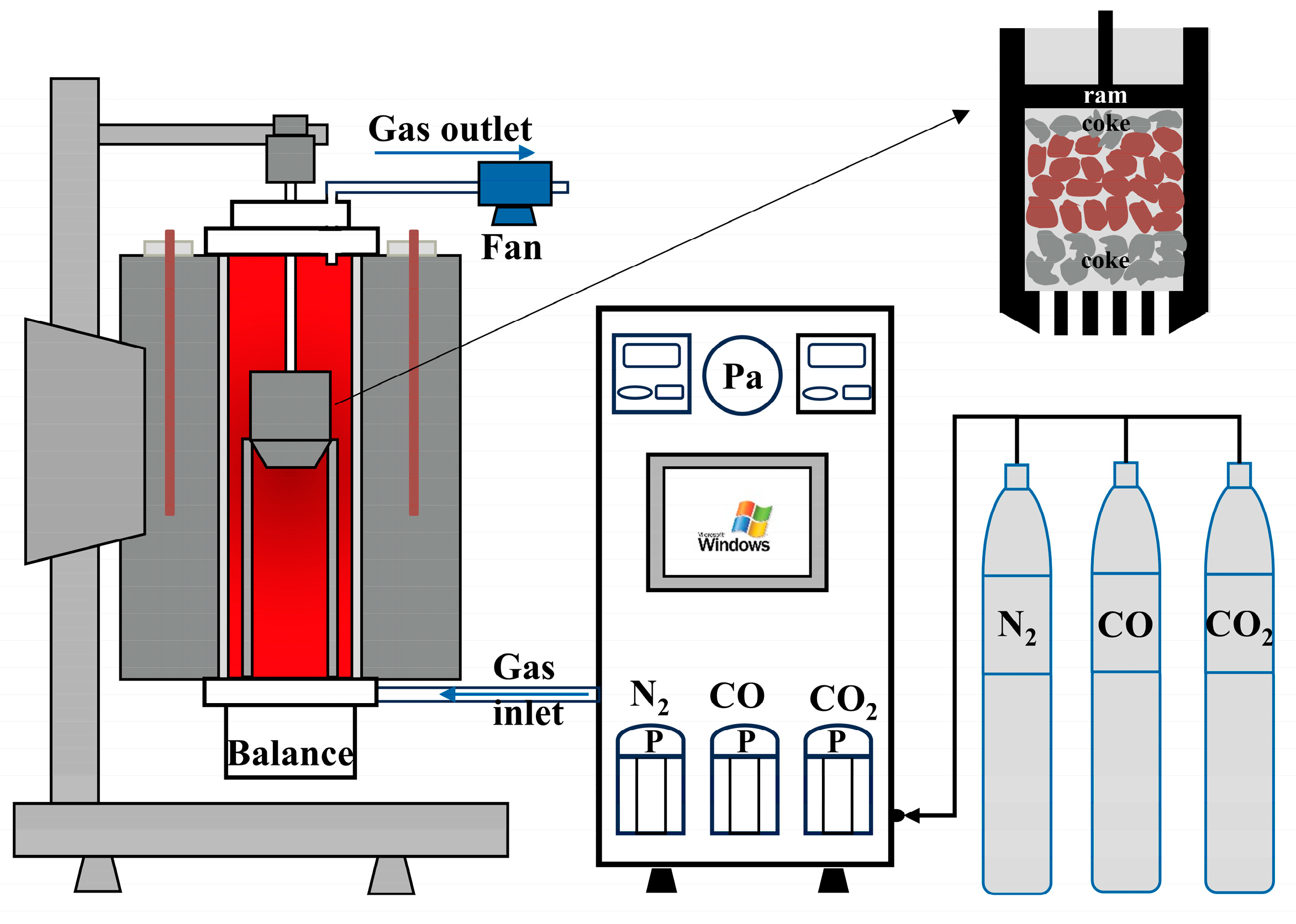
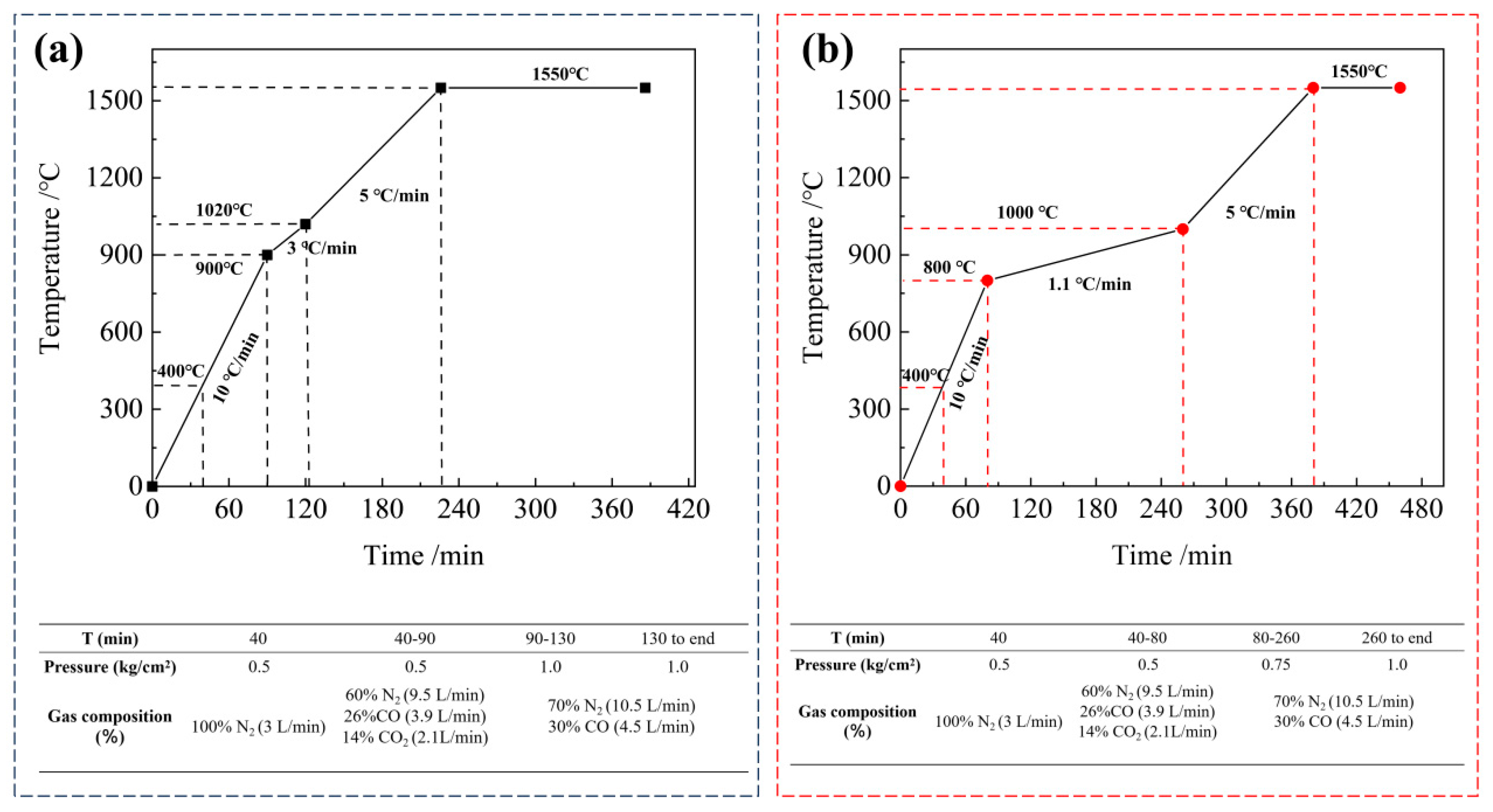

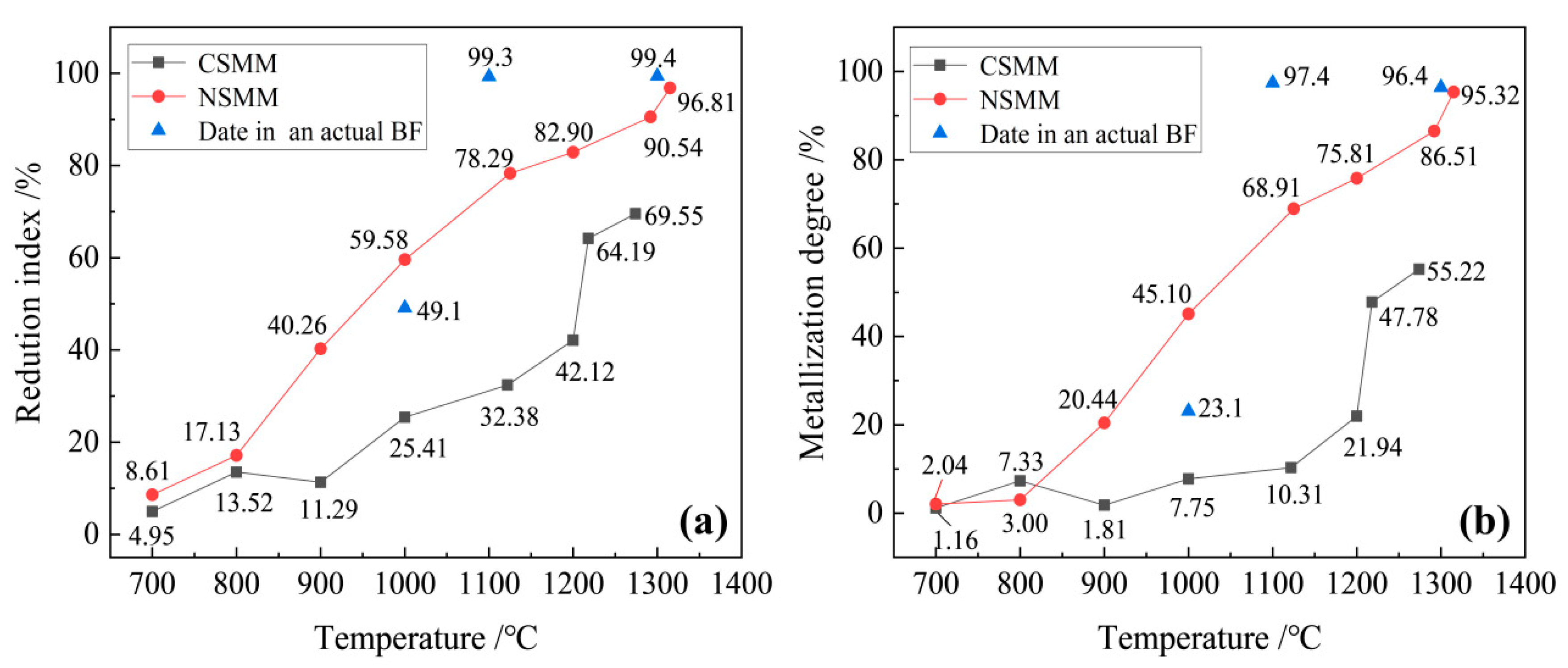
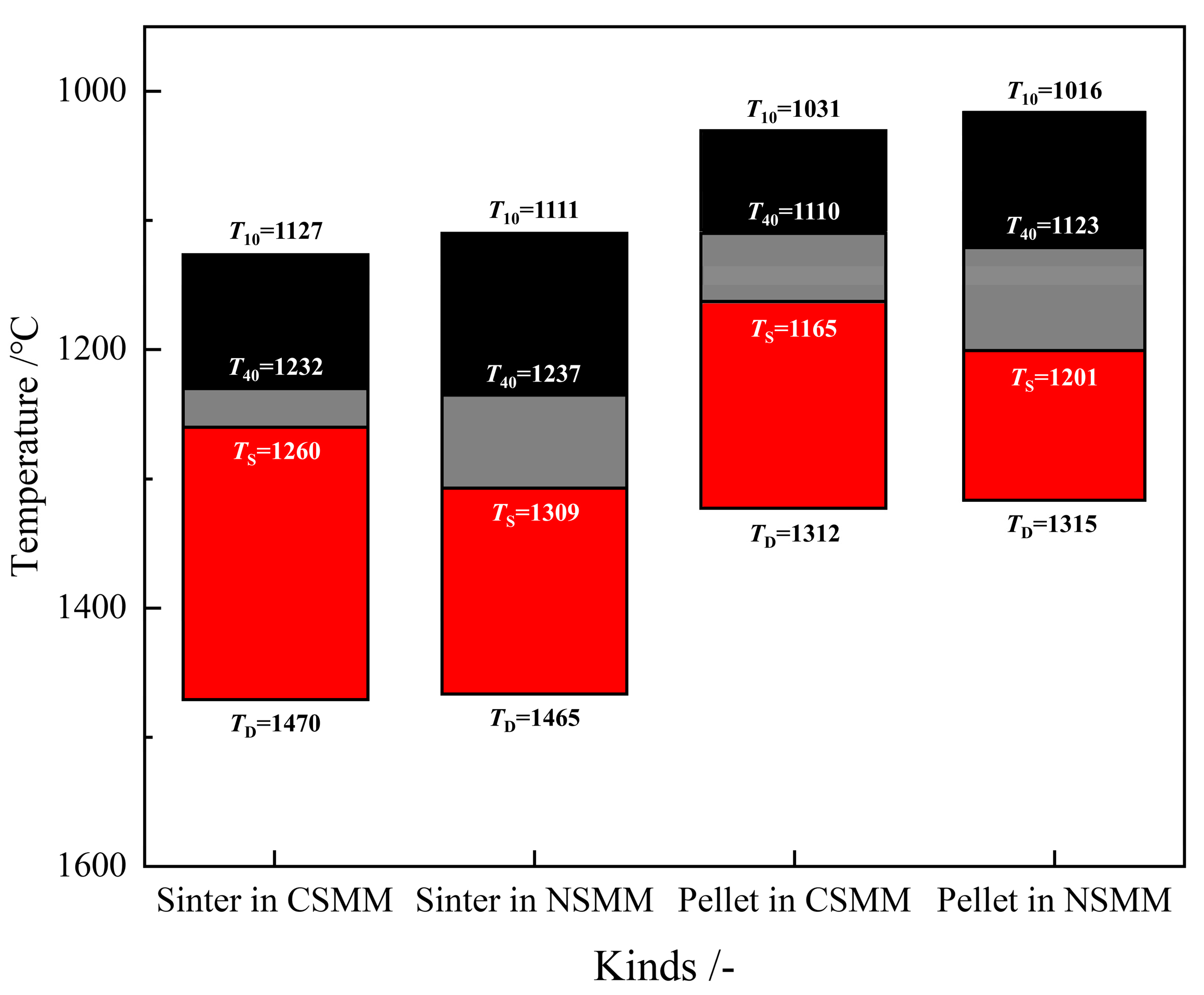
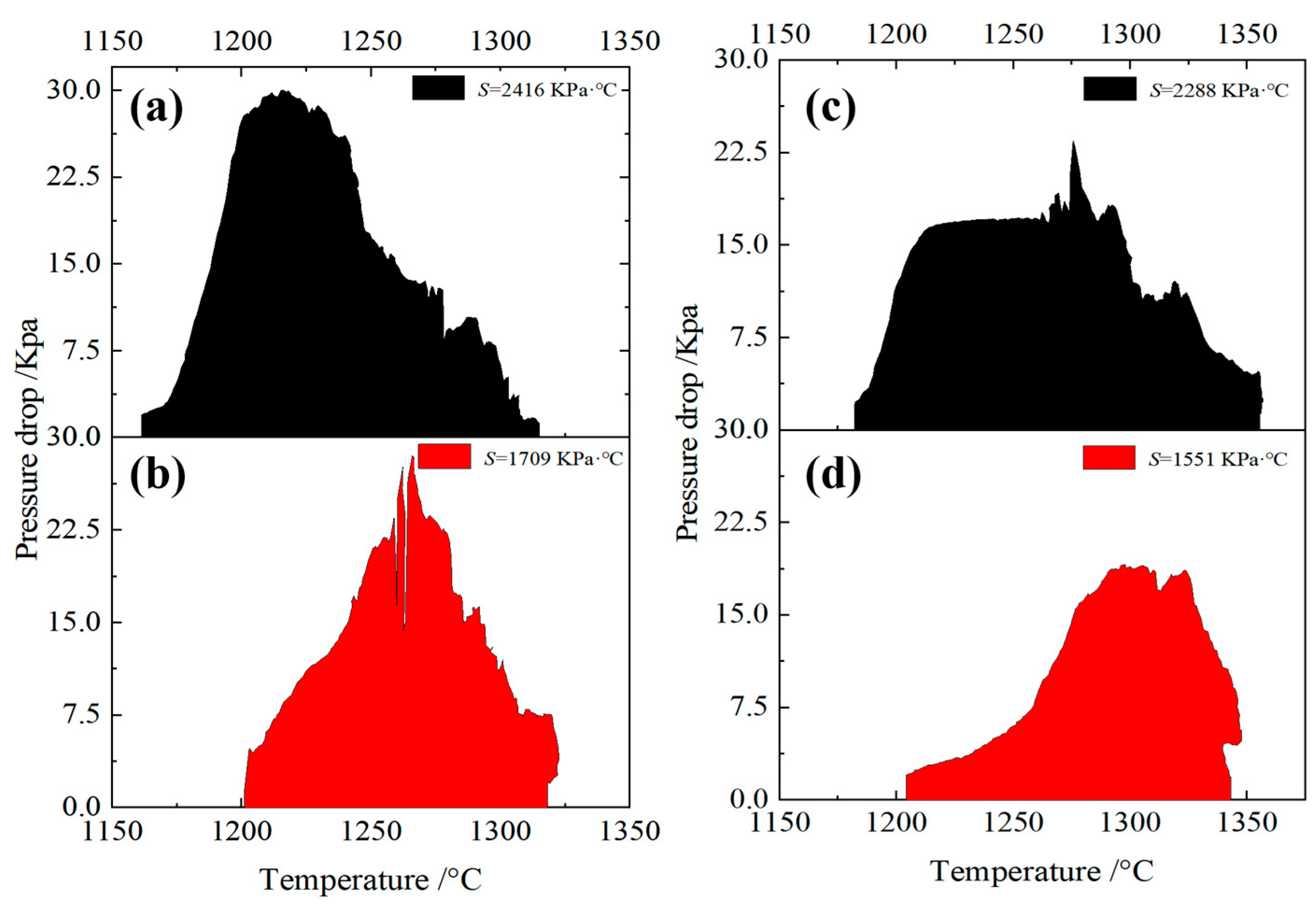
| Ores | TFe | FeO | CaO | SiO2 | MgO | Al2O3 |
|---|---|---|---|---|---|---|
| Sinter | 54.11 | 8.48 | 12.38 | 5.83 | 1.08 | 2.06 |
| Pellet | 61.49 | 5.68 | 1.38 | 8.53 | 0.75 | 0.96 |
| Fixed Carbon | Ash | Volatile Mass | Moisture |
|---|---|---|---|
| 87.07 | 12.29 | 0.63 | 0.01 |
| Symbol | Significance |
|---|---|
| T10/°C | The beginning temperature of softening is defined as 10% shrinkage of iron-bearing materials |
| T40/°C | The softening temperature is defined as 40% shrinkage of iron-bearing materials |
| TS/°C | The melting temperature is defined as the pressure of the iron-bearing materials exceeding 2 kPa |
| Td/°C | The dripping temperature is defined as the temperature at which the first iron droplets begin to drip |
| (T40 − T10)/°C | Softening temperature zone |
| (Td − TS)/°C | Melting temperature zone |
| S /kPa·°C | Permeability index, |
| Sinter | TFe/% | FeO/% | MFe/% | RI/% |
| CSMM | 57.19 | 38.94 | 4.43 | 25.41 |
| NSMM | 60.31 | 33.68 | 27.20 | 59.58 |
| Pellet | TFe/% | FeO/% | MFe/% | RI/% |
| CSMM | 64.31 | 36.06 | 0.26 | 14.95 |
| NSMM | 69.12 | 67.88 | 10.28 | 40.34 |
| CSMM /°C | TFe /% | FeO /% | MFe /% | RI /% |
| 700 | 63.71 | 14.34 | 0.35 | 6.39 |
| 800 | 63.54 | 19.15 | 0.25 | 8.21 |
| 900 | 63.67 | 27.22 | 0.25 | 11.48 |
| 1000 | 64.31 | 36.06 | 0.26 | 14.95 |
| 1070 (T10) | 66.56 | 59.23 | 2.90 | 27.44 |
| 1180 (TS) | 69.78 | 54.54 | 17.02 | 44.66 |
| NSMM /°C | TFe /% | FeO /% | MFe /% | RI /% |
| 700 | 62.37 | 19.30 | 0.29 | 8.49 |
| 800 | 64.06 | 39.02 | 0.15 | 16.03 |
| 900 | 67.60 | 35.84 | 20.06 | 43.43 |
| 1000 | 69.12 | 67.88 | 10.28 | 40.34 |
| 1081 (T10) | 74.36 | 55.77 | 28.72 | 58.08 |
| 1204 (TS) | 73.61 | 51.44 | 31.44 | 60.84 |
| Ores | Method | Td | Initial Slag |
|---|---|---|---|
| Sinter | CSMM | 1525 °C | Non-drop |
| Sinter | NSMM | 1520 °C | Non-drop |
| Pellet | CSMM | 1348 °C | Drop |
| Pellet | NSMM | 1356 °C | Drop |
Disclaimer/Publisher’s Note: The statements, opinions and data contained in all publications are solely those of the individual author(s) and contributor(s) and not of MDPI and/or the editor(s). MDPI and/or the editor(s) disclaim responsibility for any injury to people or property resulting from any ideas, methods, instructions or products referred to in the content. |
© 2024 by the authors. Licensee MDPI, Basel, Switzerland. This article is an open access article distributed under the terms and conditions of the Creative Commons Attribution (CC BY) license (https://creativecommons.org/licenses/by/4.0/).
Share and Cite
Fan, K.; Jiang, X.; Zhang, X.; Wang, Q.; Gao, Q.; Zheng, H.; Shen, F. Investigation of the Testing Method of Softening–Melting Properties of Iron-Bearing Materials. Minerals 2024, 14, 1214. https://doi.org/10.3390/min14121214
Fan K, Jiang X, Zhang X, Wang Q, Gao Q, Zheng H, Shen F. Investigation of the Testing Method of Softening–Melting Properties of Iron-Bearing Materials. Minerals. 2024; 14(12):1214. https://doi.org/10.3390/min14121214
Chicago/Turabian StyleFan, Kai, Xin Jiang, Xin Zhang, Qingyu Wang, Qiangjian Gao, Haiyan Zheng, and Fengman Shen. 2024. "Investigation of the Testing Method of Softening–Melting Properties of Iron-Bearing Materials" Minerals 14, no. 12: 1214. https://doi.org/10.3390/min14121214
APA StyleFan, K., Jiang, X., Zhang, X., Wang, Q., Gao, Q., Zheng, H., & Shen, F. (2024). Investigation of the Testing Method of Softening–Melting Properties of Iron-Bearing Materials. Minerals, 14(12), 1214. https://doi.org/10.3390/min14121214






